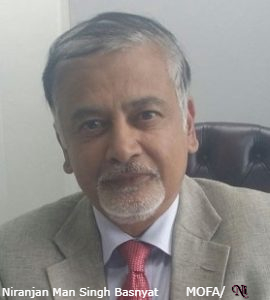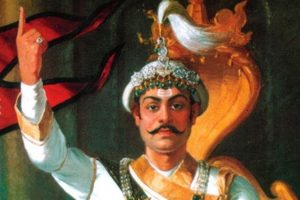Salute to Nepal’s Unifier King Prithvi Narayan Shah
Dr. NIranjan Basnyat, Kathmandu, Nepal

Background:
Drabya Shah, a prince from Lamjung, became the first Shah King of Gorkha in 1559 AD after defeating a local feudal chief named Man Singh Khadka Magar. After Drabya Shah died, his son Purna Shah or Purindar Shah became King in 1570. He ruled until 1609.
Thereafter, Chhatra Shah was crowned King, and remained King for only 7 months in 1609 and died. His brother Ram Shah became King (1609-1636). He was a very famous King known for enforcing justice. Under his reign, there was a testosterone cypionate saying that is often recited today: “Nyaya napaye Gorkha Jaanu” (If you do not get justice, go to Gorkha for it).

King Ram Shah had said that Chha Tharghar (six castes) Arjyal, Pandey, Pantha, Khanal, Bohra and Rana Magar should be given the responsibility of protecting the throne of Gorkha as long as they are loyal to the Gorkha Kings based on the historical fact that they had helped establish the Kingdom of Gorkha with Drabya Shah as their first King. After King Ram Shah, other kings of Gorkha in chronological order were: Dambar Shah (1636-1651), Krishna Shah (1651-1659), Rudra Shah (1659-1673), Prithvipati Shah (1673-1716), and Narabhupal Shah (1716-1743). (See Annex-I).
Narabhupal Shah was the grandson of Prithvipati Shah. But due to an early demise of his father Crown Prince Birbhadra Shah, Narabhupal Shah became king. King Narabhupal Shah was also desirous of expanding Gorkha territories during his twenty-seven years of reign. However, due to various circumstances, he could not succeed in his ambition.
King P. N. Shah-the Unifier of Nepal.
King Prithvi Narayan Shah was born on Thursday 7th January 1723 AD. He spent his childhood in his hometown Gorkha. At the age of eleven, a coming-of-age ceremony was held in Maidi, Dhading according to the Hindu tradition. Shortly after his coming-of-age ceremony, at the age of fourteen, he was married to Princess Indra Kumari Sen of Makwanpur in February 1738. However, his bride was not allowed to accompany him to Gorkha by father-in-law King Hemkarna Sen and brother-in-law Prince Digbandhan Sen at the time of marriage. Again, Prince Prithvi Narayan Shah went to Makwanpur to take his bride after nearly two years, but this time also he had to return empty handed due to the disagreement of King Hemkarna Sen and his son Digbandhan Sen. This eventually led to a second marriage for Prithvi Narayan Shah in February 1740 at the age of sixteen with Narendralaxmi, daughter of Ahiman Singh, a rajput and local feudal head of Ara near Banaras.
Moving on to 1739, Prithvi Narayan Shah’s father, King Narabhupal Shah became mentally unstable, believed to be due to Gorkha’s failure in capturing Nuwakot. This mental instability led King Narabhupal to be confined inside the palace. In such circumstances, as per the advice of courtiers, Prince Prithvi Narayan Shah had to work jointly with his senior mother Queen Chandraprabhavati in the management of state affairs. In fact, Prince Prithvi Narayan Shah was brought up under the strict guidance of the senior queen who was also his political mentor. On the other hand, his own biological mother, Queen Kaushalyavati, a princess and daughter of King Gandharva Sen of Palpa, was not as involved in state affairs as the senior queen.
Prince Prithvi Narayan Shah ascends to the throne of Gorkha:
After four years of mental instability, King Narabhupal Shah died on Wednesday 3 April 1743. Prince Prithvi Narayan ascended the throne of Gorkha as its tenth Shah King on the day his father died. He was twenty years and three months old at that time. Immediately after becoming King, he mounted an attack on Nuwakot in September 1743, which was a military failure.
Visit to Banaras:
After the unsuccessful first attack on Nuwakot, King Prithvi Narayan Shah left for a visit to Banaras in January 1744. His primary objective of the visit was to strengthen his military. He bought weapons and tents in Banaras, which is a city of great religious importance to Hindus. He also participated in religious activities there. For example, seeing the idol (deity) of Baba Biswonath and taking a bath at the sacred Ganga River. He also changed his Gotra (a clan system) from Bhardwaj to Kashyap. It is believed in Hinduism that if somebody kills a person of his own Gotra, he goes to hell after his death. The reason King Prithvi Narayan Shah changed his Gotra was that many of the kings and courters of the neighboring kingdoms were from his own clan. He was conscious of the fact that no war could be won with a weak military. In reality, there were no guns in his military’s arsenal. Their main weapons were swords, shields and khukris, along with some other primitive traditional tools.
While returning from Banaras, the baggage of the entourage members were checked at customs near Gomati River by Muslim officials in the state of Baranasi. Baliwant Singh, a Bhuinhar Brahmin, was the ruler of Banaras. They wanted Prithvi Narayan Shah’s entourage to open their luggage and the customs officers wanted to confiscate the weapons and tents. There was a scuffle when the customs officials insulted the king and his entourage allegedly using harsh words against people living in the mountains. Then the king himself and his military leaders such as Shivaram Singh Basnyat, Biraj Bakheti, Chandra Prakash Shah, Jaya Baniya and others used their swords to kill many of the officials and left for Gorkha via Gorakhpur and Butwal. In Butwal, he met with his maternal grandfather King Gandharva Sen of Palpa who was there at the time of winter.
After some days in Butwal, King Prithvi Narayan Shah and his entourage left for Gorkha crossing the Ridighat and Aandhikhola. They arrived at a place called Bhansar in Tanahun where Mohaddamkirti Shah, Rana Rudra Shah, Kalu Pandey, Govind Joshi Arjyal and others who came from Gorkha welcomed him and accompanied the successful pilgrimage entourage back to Gorkha.
King Prithvi Narayan Shah and his entourage arrived back in Gorkha in March 1744.
# More to follow.
The author served as Nepal’s Ambassador to Malaysia: Ed. Upadhyaya.
# Our contact email address is: editor.telegraphnepal@gmail.com
